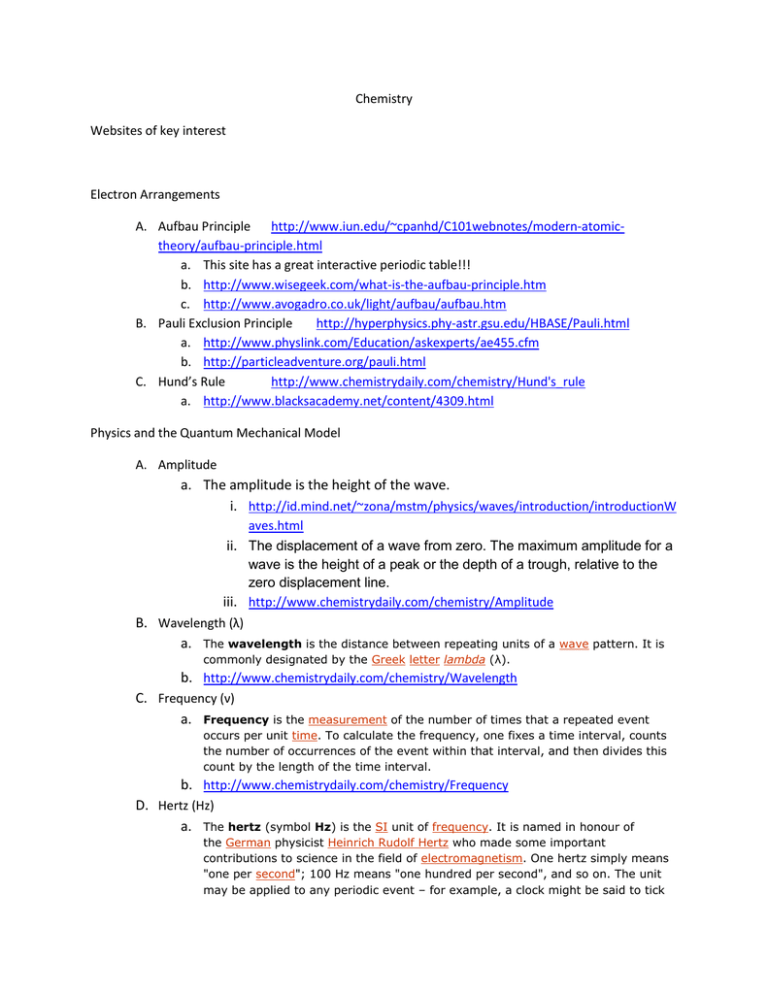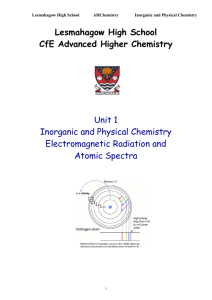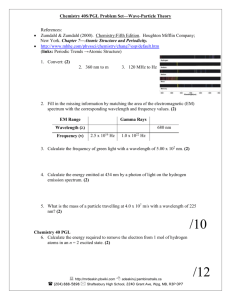ChemistryChapter 5.2 and 5.3 Key Help
advertisement

Chemistry Websites of key interest Electron Arrangements A. Aufbau Principle http://www.iun.edu/~cpanhd/C101webnotes/modern-atomictheory/aufbau-principle.html a. This site has a great interactive periodic table!!! b. http://www.wisegeek.com/what-is-the-aufbau-principle.htm c. http://www.avogadro.co.uk/light/aufbau/aufbau.htm B. Pauli Exclusion Principle http://hyperphysics.phy-astr.gsu.edu/HBASE/Pauli.html a. http://www.physlink.com/Education/askexperts/ae455.cfm b. http://particleadventure.org/pauli.html C. Hund’s Rule http://www.chemistrydaily.com/chemistry/Hund's_rule a. http://www.blacksacademy.net/content/4309.html Physics and the Quantum Mechanical Model A. Amplitude a. The amplitude is the height of the wave. i. http://id.mind.net/~zona/mstm/physics/waves/introduction/introductionW aves.html ii. The displacement of a wave from zero. The maximum amplitude for a wave is the height of a peak or the depth of a trough, relative to the zero displacement line. iii. http://www.chemistrydaily.com/chemistry/Amplitude B. Wavelength (λ) a. The wavelength is the distance between repeating units of a wave pattern. It is commonly designated by the Greek letter lambda (λ). b. http://www.chemistrydaily.com/chemistry/Wavelength C. Frequency (ν) a. Frequency is the measurement of the number of times that a repeated event occurs per unit time. To calculate the frequency, one fixes a time interval, counts the number of occurrences of the event within that interval, and then divides this count by the length of the time interval. b. http://www.chemistrydaily.com/chemistry/Frequency D. Hertz (Hz) a. The hertz (symbol Hz) is the SI unit of frequency. It is named in honour of the German physicist Heinrich Rudolf Hertz who made some important contributions to science in the field of electromagnetism. One hertz simply means "one per second"; 100 Hz means "one hundred per second", and so on. The unit may be applied to any periodic event – for example, a clock might be said to tick at 1 Hz. The name hertz was adopted by the CGPM in 1960, replacing the previous name for the unit, cycles per second (cps), along with its related multiples (kilocycles,megacycles, and so forth). Hertz replaced cycles in common use by 1970. b. http://www.chemistrydaily.com/chemistry/Hertz E. Electromagnetic Radiation a. Electromagnetic radiation or EM radiation is a combination (cross product) of oscillating electric and magnetic fields perpendicular to each other, moving through space as a wave, effectively transporting energy and momentum. EM radiation is quantized as particles called photons. EM radiation with a wavelength between 400 nm and 700 nm is detected by the human eye and perceived as visible light. The physics of electromagnetic radiation is electrodynamics, a subfield ofelectromagnetism. b. http://www.chemistrydaily.com/chemistry/Electromagnetic_radiation F. Spectrum G. In the 17th century the word spectrum was introduced into optics, referring to the range of colors observed when white light was dispersed through a prism. Soon the term referred to a plot of light intensity as a function of frequency or wavelength. Max Planck later realized that frequency represents electromagneticenergy: E = hν , where E is the energy of a photon, h is Planck's constant, and ν is the frequency of the light. a. http://www.chemistrydaily.com/chemistry/Spectrum H. Atomic Emission Spectrum a. A material's emission spectrum is the amount of electromagnetic radiation of each frequency it emits when it is heated (or more generally when it is excited). b. http://www.chemistrydaily.com/chemistry/Emission_spectrum I. Ground State a. In physics, the ground state of a quantum mechanical system is its lowestenergy state. An excited state is any state with energy greater than the ground state. b. http://www.chemistrydaily.com/chemistry/Ground_state J. Photons a. In physics, the photon (from Greek φοτος, meaning light) is a quantum of excitation of the quantised electromagnetic field and is one of the elementary particlesstudied by quantum electrodynamics (QED) which is the oldest part of the Standard Model of particle physics. i. http://www.chemistrydaily.com/chemistry/Photons K. Heisenberg Uncertainty Principle a. In quantum physics, the Heisenberg uncertainty principle, sometimes called the Heisenberg indeterminacy principle, expresses a limitation on accuracy of (nearly) simultaneous measurement of observables such as the position and the momentum of a particle. It furthermore precisely quantifies the imprecision by providing a lower bound (greater than zero) for the product of the dispersions of the measurements. For instance, consider repeated trials of the following experiment: By an operational process, a particle is prepared in a definite state and two successive measurements are performed on the particle. The first one measures its position and the second immediately after measures its momentum. Suppose furthermore that the operational process of preparing the state is such that on every trial the first measurement yields the same value, or at least a distribution of values with a very small dispersion dp around a value p. Then the second measurement will have a distribution of values whose dispersion dq is at least inversely proportional to dp. b. http://www.chemistrydaily.com/chemistry/Heisenberg_uncertainty_principle




